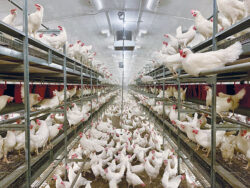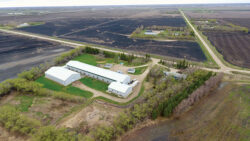
Features
Farm Focus
Top farm profile of 2023: Feeding for comfort and welfare
By Julienne Isaacs
How a Manitoba chicken and egg farm changed things up.
 The Siemens family at Manitoba’s Outstanding Young Farmers of the Year award ceremony, 2023. L-R: Harley, Sawyer, TaNeille, Brooklyn and Beckett Siemens.
All images courtesy of Harley and Brooklyn Siemens
The Siemens family at Manitoba’s Outstanding Young Farmers of the Year award ceremony, 2023. L-R: Harley, Sawyer, TaNeille, Brooklyn and Beckett Siemens.
All images courtesy of Harley and Brooklyn Siemens Harley and Brooklyn Siemens have plenty of reasons to celebrate: the Rosenort, Man. egg farmers were recently named Manitoba’s Outstanding Young Farmers of the Year. But they simply haven’t had time.
“I have had the busiest six to seven weeks of my life, so we haven’t celebrated yet,” says Siemens. “We’ve been going pretty fast the last couple of years – building barns, buying farms, having a family of three [children] under five – it’s been a whirlwind.”
In 2017, the Siemens reinvented their operation, starting with a brand-new free-run facility, which can hold 32,000 birds, at their family farm in Rosenort. They also built a pullet training facility with a capacity of 27,000. In 2020, they bought into a company called Manova, which owns a 50,000-bird enriched housing layer barn in Blumenort, Man. and a 18,000-bird conventional housing layer barn in Niverville, Man. Siemens serves as the president of the Manova corporation, and within a few months of buying in, he’d renovated the Niverville barn into a brand-new free-run aviary-style barn.Between all sites, Siemens Farms produces about 90,000 eggs per day (about 7,500 dozen), which are shipped across Canada, from B.C. to Ontario.
“Our business is all about making sure those hens are in a good environment. If they are not comfortable, they don’t produce high-quality eggs. I want to make sure they’re given all the necessary tools, space and enhancements so they are happy,” says Siemens. “When we were looking at rebuilding our facilities, free-run [housing] was a new technology that wasn’t very well known here in Manitoba. We toured a couple of facilities and we really liked the work that was being done, and the benefits for the hen, to be able to express her natural abilities,” he adds.
Manitoba’s commercial egg farmers are regulated: each egg producer must obtain quota to produce eggs and cannot own more than 125,000 birds. Egg prices are set by Manitoba Egg Farmers. All Canadian egg farmers must participate in the national Animal Care Program, which is managed by Egg Farmers of Canada; the latter conducts bi-annual on-farm audits under a program called Start Clean, Stay Clean to make sure farmers are meeting industry standards for animal care as well as storage, cleanliness, air quality, feed and record keeping. Third-party audits are also conducted to ensure farmers abide by the Animal Care Program, and Siemens and his staff are constantly researching and testing new methods to boost efficiency and improve the quality of life for pullets and hens.
Feeding strategies
Feed is one very important element of chicken welfare. This is another area where regulations come into play, notes Siemens: each farm pays a dietician and the provincial feed representative to help set suitable diets based on animals’ housing and many other factors.

The free-run layer barn can host 32,000 birds.
“Here in Manitoba, nobody knows what the feed ration is. The ration is a trade secret,” says Siemens. “I’ll know the main ingredients they’re given, [especially] the protein levels, because we adjust this constantly – the older they get, the less protein they need.”
In the laying hen barn, they use their trademarked “tandem ration” or AM/PM diet: an automated system that pulls from two bins using slides to pull different types of feed depending on the time of day. In the morning, the system provides two feedings of a high-protein, high-vitamin feed to help hens develop yolks; in the afternoon, three separate high-calcium feedings are provided, to help hens build shells.
“Then we continue that rotation,” he explains. “There’s a bit of a cost savings to do this, because calcium is cheaper than buying protein for feed. But it’s a very technical ration: a 60/40 split, with 60 per cent of their feed in the afternoon and 40 per cent in the morning.”
In the pullet barn, pullets are raised in cages for the first three to four weeks, after which the barn is converted to a free-run barn; the doors of the cages open to create “balconies” for the birds, with ladders down to the barn floor. Feed is provided in the cages; during the day, the birds play on the floor, and in the evening the animals have to climb back into their cages for food and water. After the four-week stage, rations increase to provide the birds enough energy to build bone structure and learn to fly.
Teaching pullets to climb the ladders to their cages is a major point of concern. Over the last five years, he says, they’ve trained 16,000 birds. Initially, it took six weeks to train flocks to climb ladders to their cages; now they’re down to two weeks.
“The most important thing is lighting – we have a special lighting program with different lights underneath and in the ceiling, [and] we have a special sundown program. We turn different things off and attract them to come up,” says Siemens. “Every barn is different and every flock is different. It’s a lot of watching the birds and how they’re using the ladders. The sooner you can get them trained, you save a lot of work.”
Siemens says free-run eat more than chickens in closed housing due to their higher activity levels, and this can get expensive. They’re constantly trying to reach an ideal conversion rate, where the birds are getting enough – but not too much – feed.
“From a broader point of view, we’re always looking at different gut health and probiotics that are in the feed that can promote the health of the hen,” he says.
One practical way this can improve hen health is in extending its laying period. In the past, most hens in Siemens Farms barns could lay for about 12 months before the shell quality started to deteriorate. With improved rations, they make it to 13 to 14 months. “It’s important for the hen to be well, [and] we need a good feed pattern to have good longevity,” he says.
Advocacy

Between all of their sites, Siemens Farms produces about 7500 dozen eggs per day (about 90,000 eggs).
The Siemens family is excited to start slowing down after a busy few years of expansion. But they’re by no means resting on their laurels. Siemens is a district representative on the board of Manitoba Egg Farmers, and he serves on a few of its committees.
He’s also an enthusiastic public speaker and works closely with Manitoba Egg Farmers on events, tours and speaking engagements. He’s done similar advocacy work with Egg Farmers of Canada, talking to chefs, distributors and members of the public about egg production. Siemens and his father, Kurt, were present at the recent grand opening of the Manitoba Egg Farmers’ new free-run research facility at Glenlea Research Station.
“Can’t wait for the public to experience where they get their eggs from,” Siemens Tweeted afterward. “We love what we do.”
Print this page